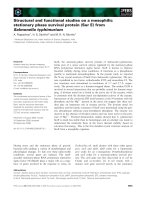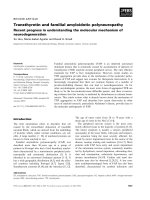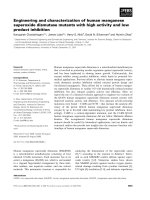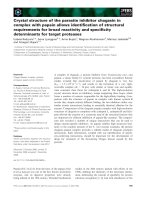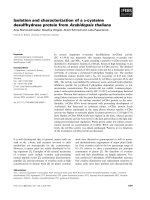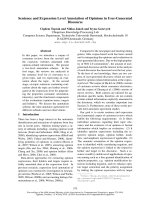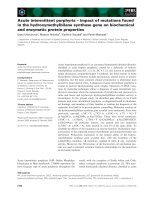báo cáo khoa học:"Spinsterhood and its impact on disease features in women with rheumatoid arthritis" pptx
Bạn đang xem bản rút gọn của tài liệu. Xem và tải ngay bản đầy đủ của tài liệu tại đây (209.48 KB, 4 trang )
RESEARCH Open Access
Spinsterhood and its impact on disease features
in women with rheumatoid arthritis
Yousra Ibn Yacoub
*
, Bouchra Amine, Assia Laatiris and Najia Hajjaj-Hassouni
Abstract
Objective: To evaluate the impact of spinsterhood on disease characteristics and quality of life (QoL) in Moroccan
women with rheumatoid arthritis (RA).
Methods: 185 women with RA were recruited in this study. Marital status was specified as follow: 1. Spinsterhood
(never-married woman aged 38 or over), 2. Distressed marriage; 3. Nondistressed marriage and 4. Divorced or
widowed. Marital distress was assessed by a self-report concerning coping efficacy and burden caring of husbands.
Assessment criteria included the evaluation of: age at onset (years), diagnosis delay (months), disease duration
(years), disease activity (evaluated by physical examination, biological inflammatory tests; and disease activity score
(DAS 28)), pain intensity (measured with a visual analogue scale (VAS)); and radiographic damage (evaluated by the
Sharp’s method as modified by van der Heijde). Treatments (doses and duration) were specified. The Health
Assessment Questionnaire (HAQ) was used to evaluate functional disability. QoL was measured using the Arabic
version of the generic instrument SF-36.
Results: In our data, spinsterhood was detected in 42 (22.7%) patients vs. 88 (47.5%) with distressed marriage, 28
(15.1%) with nondistressed marriage and 27 (14.6%) divorced or widowed. Comparing the 4 groups, we found that
QoL in never-married women was damaged in a significant way comparing to the other groups. Mental as well as
physical aspects were affected. Also, we found that spinsterhood was associated to an early age at onset (p =
0.009), pain intensity (p < 0.001); clinical (p < 0.001) and biological disease activity (C-reactive protein; p = 0.02) and
functional disability (p < 0.001). Logistic regression analysis revealed a significant relationship between spinsterhood
and early age at onset and severe functional disability (for all p ≤ 0.01).
Conclusion: This study suggests that spinsterhood in our RA patients was associated with an altered QoL even
compared with distressed married women. Also, we state that spinsterhood was associated wi th an early age at
onset, severe joint pain; higher disease activity and with altered functional ability. It seems important to consider
not only disease-related parameters but also social status as a determinant factor of poor course in RA.
Introduction
Rheumatoid arthritis (RA) is a chronic inflammatory
disease which has gre at impact on general well-being,
functions of daily life and the fulfillment of social roles
[1]. The course of RA is multi-dimensional and varies
greatly among patients [2,3]. Beside disease-related para-
meters, sociodemographic factors may affect disease
activity, function and general well-being in RA [1,3]. It
has been suggested that marital status could be asso-
ciated with worse outcome in women with RA and t hat
marriage may be associated with a lower rate of
progression of functional disability in persons with RA
[3,4]. However, in spite of previous data, it remains diffi-
cult to conclude whether or not marital status is a
determinant of severity of RA [3].
In the Arab region, demographic patterns of marriage
status have changed significantly in recent decades [5].
Early marriage has declined sharply in parts of the Arab
world and the rate of celibacy or spinsterhood has
increased significantly [5]. To our knowledge, no Magh-
rebean or Arabic data have focused on the impact of
spinsterhood on disease characteristics among women
with RA. The aim of the present study was to evaluate
spinsterhood and its relationships wi th disease variables
and quality of life (QoL) in Moroccan women with RA.
* Correspondence:
Department of Rheumatology (Pr N. Hajjaj-Hassouni), El Ayachi Hospital,
University Hospital of Rabat-Sale, Morocco
Ibn Yacoub et al. Health and Quality of Life Outcomes 2011, 9:58
/>© 2011 Ibn Yacoub et al; licensee BioMed Central Ltd. This is an Open Access article distribu ted under the terms of the Creative
Commons Attribution License ( which permits unrest ricted use, distribution, and
reproduction in any medium, provided the original work is properly cited.
Patients and me thods
Patients
185 women with the diagnosis of RA were recruited
consecutively at the Department of Rheumatology of El
Ayachi Hospit al in the Univ ersi ty hospital of Rabat-Sale
in Morocco between October 2009 and November 2010.
Informed consent was obtained from all patients and
the local medical Ethics Committee approved the study .
Patients were recruited in consultation or during hospi-
talization. For all patients were collected: age, educa-
tional level (subdivided into three groups: no formal
education, primary education; and secondary education
or more), socioeconomic status (determined by the
monthly household income (less than 1000 Dirhams
(DH), between 1000 and 2000 DH; 2000 and 5000 DH
and above 5000), disease duration (years), diagnosis
delay (months), morning stiffness (minutes), night pain
(number of awakenings) and pain intensity (visual analo-
guescale(VAS):0-100mm,0=nopainand100=
severe pain imaginable). Disease activity was evaluated
clinically by the duration of morning stiffness (minutes),
night pain, number of swollen and tender joints; biologi-
cally by the erythrocyte sedimentation rate (ESR) and C
reactive protein (CRP); and by the disease activity score
(DAS 28). For structural damage, radiographs of hands,
wrists and feet were evaluated by one observer and
scored using Sharp’smethodasmodifiedbyvander
Heijde [6]. Functional disability was assessed by using
the Moroccan version of Health Assessment Question-
naire (HAQ) [7].
Were collected also: extra-articular manifestations,
immunological abnormalities (rheumatoid factor rate
(RF) and anti-cyclic citrullinated protein (CCP) antibody
positivity by Elisa method), and treatment (doses and
duration) with corticosteroids, disease modifying anti
rheumatic drugs (DMARD’s) and biologic agents. The
quality of life (QoL) was evaluated using the Arabic ver-
sion of the Medical Outcomes Study Short Form 36
Health Survey: the SF-36; validated in Morocco [8].
Marital status
Marital status was categorized in four groups: 1. Spin-
sterhood (never married woman aged 38 or over), 2.
Distressed marriage; 3 . Nondistressed marriage and 4.
Divorced or widowed. Never-married women younger
than 38 years-old were exclude d from the sample. Ma ri-
tal distress was assessed by a self-report concerning cop-
ing efficacy and burden caring of husbands.
Statistical analysis
The statistical analyses were carried out using the SPSS
13 for Windows (SPSS Inc., Chicago, IL, USA). Data for
patients were presented as mean and standard devia-
tions for c ontinuous variables and as frequencies and
percentages for categorical variables. Differences within
the 4 groups were assessed by using the ANOVAs Ana-
lysis of variance. Logistic regression was used to assess
disease parameters related to spinsterhood. Results of
logistic regression were presented a s odds Ratios (OR)
with 95% confidence intervals (CI). Odds Ratios were
adj usted for the potential confounders (age, educational
level, socioeconomic status and treatment) to examine
the independent association between spinsterhood and
disease parameters. The significance level of P was set at
0.05.
Results
In our sample, the mean age of patients was 46.57 ±
10.78 years. The mean age at onset was 35.3 ± 12 years
and the mean disease duration was 10.58 ± 8.13 years.
Spinsterhood was detected in 42 (22.7%) patients vs. 88
(47.5%) with distressed marriage, 28 (15.1%) w ith non-
distressed marriage and 27 (14.6%) divorced or
widowed. In ANOVAs Analysis of variance performed
with Bonferroni correction, we found that spinsterhood
was associated to an early age at onset (p = 0.009), pain
intensity (VAS pain) (p < 0.001); clinical and bi ological
disease activity (DAS28 (p < 0.001) and CRP (p = 0.02))
and functional disability (HAQ) (p < 0.001). Patients’
characteristi cs and disease-related variables according to
the marital stat us are summarized in table 1. There
were no statistically significant differences in structural
damage, immunological status, extra-articular manifesta-
tions or treatment modalities between the four groups.
Also, spinsterhood was associated to lower scores of
QoL comparing to the other groups (Table 2). Mental
as well as physical aspects were affected in a significant
way in never-married women. The logistic regression
analysis revealed a significant independent relationship
between spinsterhood and early age at onset [OR =
1.217-CI (95%) 1.136-1.303] and severe functional dis-
ability (HAQ) [OR = 2.772-CI (95%) 1.217-1.669] (for all
p ≤ 0.01). Likewise, in regression analysis, spinsterhood
was associated with altered scores of the domain of
mental health [OR = 1.086-CI (95%) 1.033-1.413] and
social functioning [OR = 2.953-CI (95%) 0.710-0.998] of
SF-36 (for all p ≤ 0.001).
Discussion
In our sample, we state the high prevalence of spinster-
hood among Moroccan women with RA comparing to
the general population (approximately 16%) [5]. Spin-
sterhood seems to be associated with joint pain, high
disease activity and worse functional disability in our
RA patients. In their study , Reese et al suggested that
relationships may influence adjustment to chronic pain
conditions such as RA [9]. Also, marital status and mar-
ital adjustment have been considered to be related to
higher pain, higher disease activity and severe physical
Ibn Yacoub et al. Health and Quality of Life Outcomes 2011, 9:58
/>Page 2 of 4
and psychological di sability in previous data [3,4,9,10].
Moreover, as in our study, other authors have found
that unmarried women had poorer HAQ scores [4,11].
However, it has been shown that being married in itself
is not associated with better health in RA but that being
in a well-adjusted or nondistressed marriage is linked
with less pain and better functioning [11]. In fact, the
associations between spinsterhood and disease
progression and severity in RA are complex and inter-
pretation requires simultaneous assessment of a variety
of other variables [10].
In our data, never marri ed women had worse disease
features even compared with distressed married women.
Cultural, social, behavioral and religious characteristics
and particularities in Arab societies may explain our
results [12].
Table 1 Study population characteristics according to the marital status (n = 185)
Characteristics Spinsterhood Distressed marriage Nondistressed marriage Divorced or widowed P
Educational level
-No formal education 15 (35.71%) 39 (44.31%) 19 (67.85%) 22 (81.48%) 0.010
-Primary education 11 (26.19%) 26 (29.54%) 2 (7.14%) 2 (7.4%)
- ≥ Secondary education 16 (38.1%) 23 (26.13) 7 (25%) 3 (11.11%)
Household income (DH)
≤ less than 1000 20 (47.62%) 44 (50%) 11 (39.28%) 12 (44.45%) 0.042
> 1000- < 2000 15 (35.72%) 30 (34.1%) 7 (25%) 11 (40.75%)
≥ 2000- < 5000 5 (11.9%) 9 (10.22%) 4 (14.28%) 3 (11.1%)
≥ 5000 2 (4.76%) 5 (5.68%) 6 (21.42%) 1 (3.7%)
Treatment
-Corticosteroids 40 (95.23%) 82 (93.18%) 24 (85.71%) 26 (96.29%) 0.139
-DMARD’s 36 (85.71%) 78 (88.63%) 23 (82.14%) 25 (92.59%) 0.282
-Biologic agents 7 (16.66%) 12 (13.63%) 4 (14.28%) 1 (3.7%) 0.096
Age (years) 44.33 ± 2.54 39.21 ± 6.48 47.27 ± 3.22 55.76 ± 5.66 0.003
Age at onset (years) 29.81 ± 11.65 36.52 ± 11.76 34.6 ± 12.23 34.72 ± 12.34 0.009
VAS pain intensity (0-100) 67.14 ± 18.11 55.14 ± 16.08 53.63 ± 12.01 52.37 ± 14.21 < 0.001
Morning stiffness(min) 72.05 ± 16.38 47.16 ± 14.66 48.37 ± 11.25 45.79 ± 16.54 0.013
Night pain (Number) 2.08 ± 0.47 1.42 ± 0.76 1.54 ± 0.57 1.44 ± 0.48 0.006
Tender joints (0-28) 14.02 ± 4.47 11.45 ± 3.27 12.07 ± 3.7 12.2 ± 3.65 0.021
Swollen joints (0-28) 7.97 ± 5.25 5.89 ± 2.42 5.3 ± 2.27 5.47 ± 3.1 0.004
ESR (mm) 47.30 ± 17.44 47.71 ± 18.37 48.79 ± 16.31 45.85 ± 19.17 0.062
CRP (mg/l) 37.07 ± 19.17 29.74 ± 13.26 30.09 ± 10.95 28.61 ± 11.93 0.02
Rheumatoid factor (UI/L) 80.52 ± 45.75 88.19 ± 39.55 88.02 ± 43.13 89.75 ± 40.07 0.203
AntiCCp antibodies (UI/L) 127.46 ± 104.36 160.2 ± 93.02 131.57 ± 97.53 110.97 ± 107.66 0.081
DAS 28 6.32 ± 1.5 5.17 ± 1.3 4.97 ± 1.94 5.04 ± 1.26 < 0.001
HAQ (0-3) 2.09 ± 0.58 1.39 ± 0.56 1.36 ± 0.68 1.23 ± 0.87 < 0.001
Sharp total score 98.45 ± 39.87 91.45 ± 35.39 91.34 ± 34.60 89.58 ± 38.61 0.317
DH, Dirhams; VAS, visual analogue scale; ESR, erythrocyte sedimentation rate; CRP, C-reactive protein; DAS, disease activity score; HAQ, health assessment
questionnaire.
P ≤ 0.05: significant
Table 2 Scores of quality of life (SF-36) according to the marital status
Domains of SF-36 Spinsterhood Distressed marriage Nondistressed marriage Divorced or widowed P
Physical functioning 39.88 ± 25.86 55.31 ± 23.83 57.55 ± 27.58 59.49 ± 28.47 < 0.001
Role limitation 36.30 ± 27.53 63.51 ± 22.05 66.11 ± 23.39 65.72 ± 29.02 0.001
Role emotional 38.46 ± 27.65 72.85 ± 26.67 73.32 ± 24.52 76.9 ± 24.77 0.003
vitality 32.28 ± 27.09 43.45 ± 17.6 44.46 ± 19.48 45.67 ± 20.08 < 0.001
Mental health 41.26 ± 10.55 54.51 ± 10.04 58.39 ± 10.54 57.25 ± 12.31 < 0.001
Social functioning 44.53 ± 17.5 65.42 ± 17.28 67.9 ± 18.94 68.74 ± 15.17 < 0.001
Bodily pain 35.70 ± 20.33 64.13 ± 20.1 66.14 ± 18.24 65.14 ± 16.46 0.002
General health 41.77 ± 15.46 64.57 ± 17.42 67.1 ± 20.49 66.17 ± 18.36 < 0.001
P ≤ 0.05: significant
Ibn Yacoub et al. Health and Quality of Life Outcomes 2011, 9:58
/>Page 3 of 4
Also, the negative impact of spinsterhood on patients’
QoL has been reported previously in RA patients [1,13].
Limitations in basic function in RA patients can under-
mine well-being and contribute to poo r QoL, perpetuat-
ing limitations in important social roles and functions of
daily life and increasing disability that, in turn may
engender poor mental and physical health [1,13].
Our results suggest that spinsterhood seems to be a
determinant factor of poor course in our RA. Those
findings may u nderscore the importance of considering
not only disease parameters but also social status parti-
cularly in our context and may inform clinical interven-
tions of RA. Large studies seem to be necessary in order
to confirm those results.
Authors’ contributions
BA and NHH conceived the study, participated in its design and have been
involved in drafting the manuscript and revising it critically for intellectual
content. YIY and AL did data management, statistical analysis and
interpretation of results. YIY wrote the manuscript with the collaboration of
all authors. All authors have given final approval of the manuscript.
Competing interests
The authors declare that they have no competing interests.
Received: 15 March 2011 Accepted: 1 August 2011
Published: 1 August 2011
References
1. Morris A, Yelin EH, Wong B, Katz PP: Patterns of psychosocial risk and
long-term outcomes in rheumatoid arthritis. Psychol Health Med 2008,
13(5):529-44.
2. Symmons DP: Epidemiology of rheumatoid arthritis: determinants of
onset, persistence and outcome. Best Pract Res Clin Rheumatol 2002,
16(5):707-22.
3. Vliet Vlieland TP, Buitenhuis NA, van Zeben D, Vandenbroucke JP,
Breedveld FC, Hazes JM: Sociodemographic factors and the outcome of
rheumatoid arthritis in young women. Ann Rheum Dis 1994, 53(12):803-6.
4. Ward MM, Leigh JP: Marital status and the progression of functional
disability in patients with rheumatoid arthritis. Arthritis Rheum 1993,
36(5):581-8.
5. Rashad H, Osman M, Roudi-Fahimi F: Marriage in the Arab World.
Population Reference Bureau 2005.
6. Van der Heijde DM, van Leeuwen MA, van Riel PL, van de Putte LB:
Radiographic progression on radiographs of hands and feet during the
first 3 years of rheumatoid arthritis measured according to Sharp’s
method (van der Heijde modification). J Rheumatol 1995, 22(9):1792-6.
7. Abourazzak FE, Benbouazza K, Amine B, Bahiri R, Lazrak N, Bzami F,
Jroundi I, Abouqal R, Guillemin F, Hajjaj-Hassouni N: Psychometric
evaluation of a Moroccan version of health assessment questionnaire
for use in Moroccan patients with rheumatoid arthritis. Rheumatol Int
2008, 28(12):1197-203.
8. Khoudri I, Ali Zeggwagh A, Abidi K, Madani N, Abouqal R: Measurement
properties of the short form 36 and health-related quality of life after
intensive care in Morocco. Acta Anaesthesiol Scand 2007, 51(2):189-97.
9. Reese JB, Somers TJ, Keefe FJ, Mosley-Williams A, Lumley MA: Pain and
functioning of rheumatoid arthritis patients based on marital status: is a
distressed marriage preferable to no marriage? J Pain 2010,
11(10):958-64.
10. Hawley DJ, Wolfe F, Cathey MA, Roberts FK: Marital status in rheumatoid
arthritis and other rheumatic disorders: a study of 7,293 patients. J
Rheumatol 1991, 18(5):654-60.
11. Bermas BL, Tucker JS, Winkelman DK, Katz JN: Marital satisfaction in
couples with rheumatoid arthritis. Arthritis Care Res 2000, 13(3):149-55.
12. Ben-Zur H: Coping, affect, and aging: the role of mastery and self
esteem. Personality and Individual Differences 2002, 32:357-372.
13. Katz P, Morris A: Time use patterns among women with rheumatoid
arthritis: Association with functional limitations and psychological status.
Rheumatol 2007, 46(3):490-495.
doi:10.1186/1477-7525-9-58
Cite this article as: Ibn Yacoub et al.: Spinsterhood and its impact on
disease features in women with rheumatoid arthritis. Health and Quality
of Life Outcomes 2011 9:58.
Submit your next manuscript to BioMed Central
and take full advantage of:
• Convenient online submission
• Thorough peer review
• No space constraints or color figure charges
• Immediate publication on acceptance
• Inclusion in PubMed, CAS, Scopus and Google Scholar
• Research which is freely available for redistribution
Submit your manuscript at
www.biomedcentral.com/submit
Ibn Yacoub et al. Health and Quality of Life Outcomes 2011, 9:58
/>Page 4 of 4
